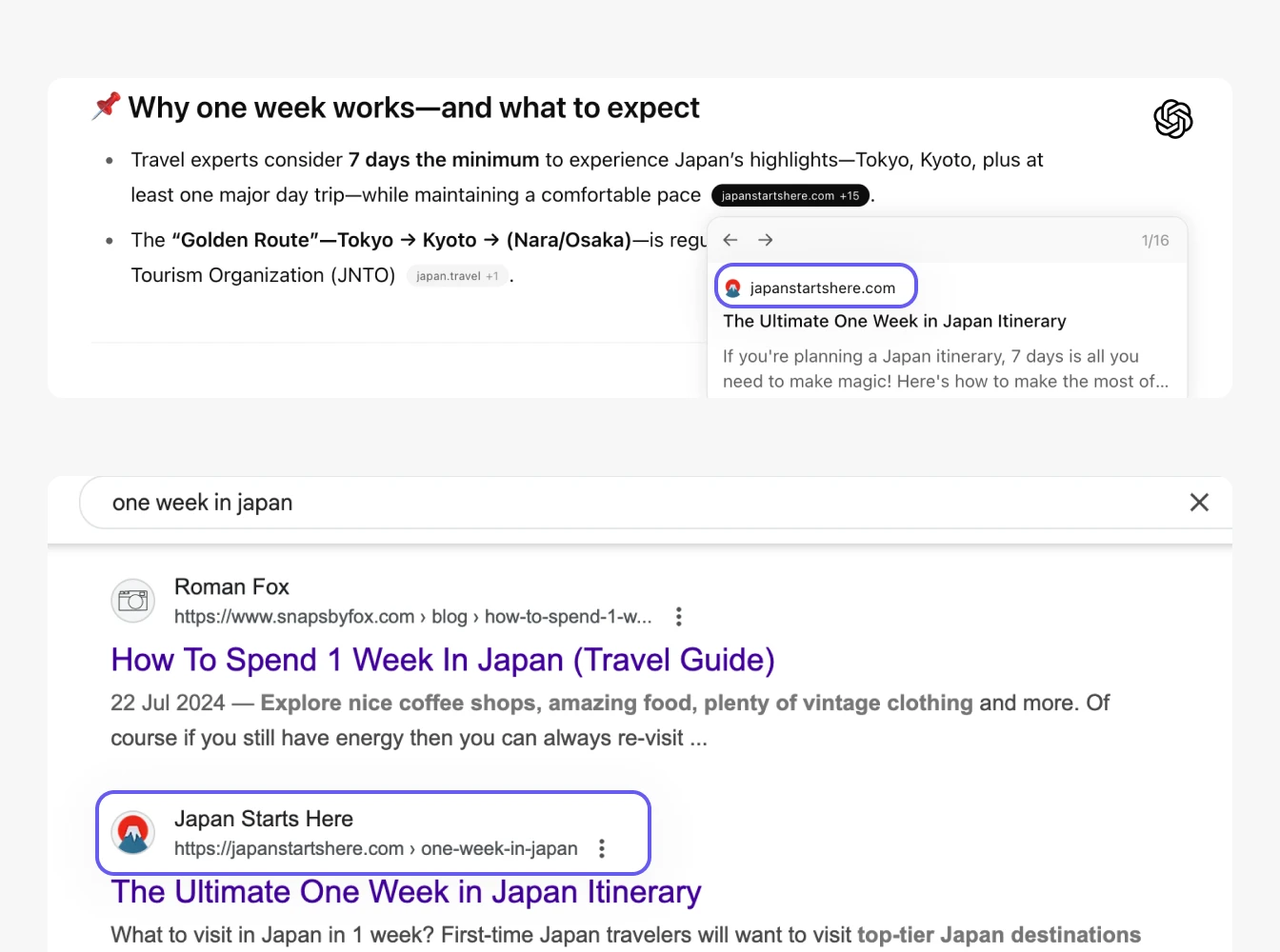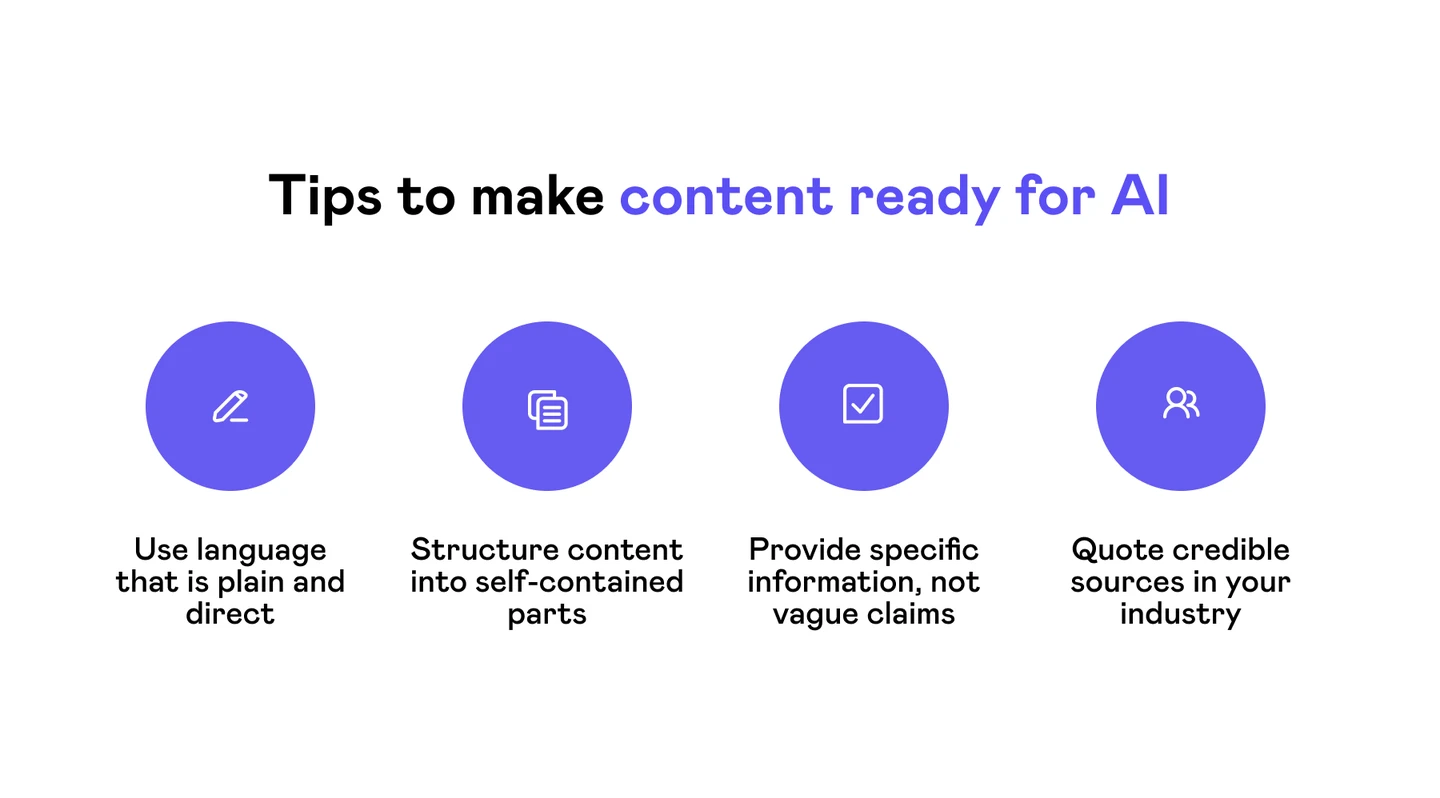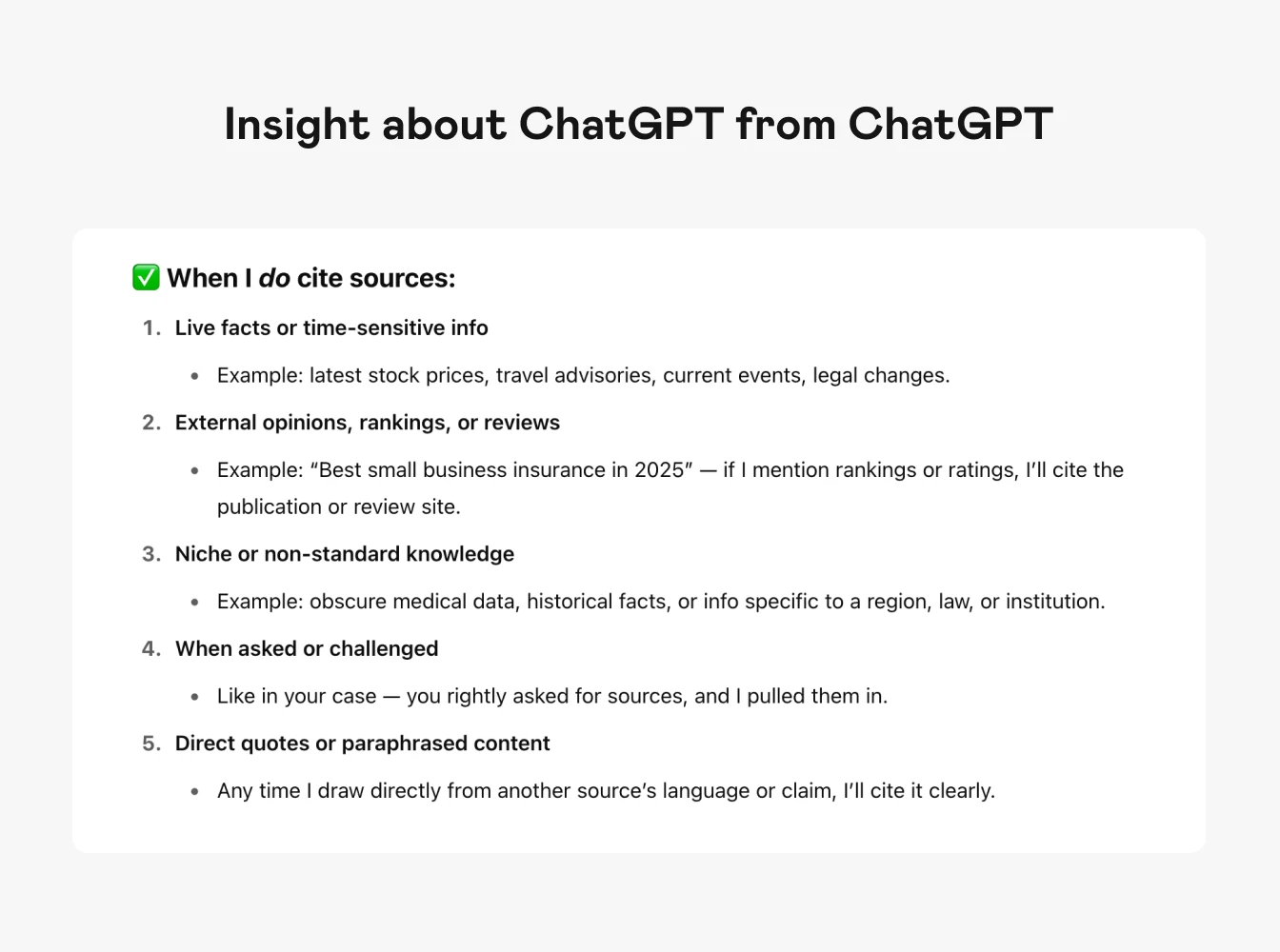Generative Engine Optimization (GEO): What you need to know
Is your content AI-ready? In this intro to Generative Engine Optimization (GEO), we cover how AI is reshaping content discovery and what that means for SEO.
Written by Monica Raszyk

Is your content AI-ready? In this intro to Generative Engine Optimization (GEO), we cover how AI is reshaping content discovery and what that means for SEO.
Written by Monica Raszyk

If you’re a content professional, you already know how to write for search engines. But today, one of your newest audiences might be an AI tool, like ChatGPT or Gemini. As people shift toward conversational search, your content now needs to serve large language models (LLMs) as well as humans.
This is the first post in a three-part series on Generative Engine Optimization (GEO), a strategy for preparing your content for AI-first discovery. Here, we’ll cover what GEO is and how it compares to traditional SEO. In parts 2 and 3, you’ll get practical tips for getting started.
GEO refers to the practice of optimizing and structuring your content to be used by AI-driven tools like chatbots, virtual assistants, and answer engines. At Kontent.ai, we’ve seen the power of structured data and modularity (like in headless CMS platforms) for easier content reuse in different contexts and on different channels. The rise of GEO is a logical and exciting new layer to a modern content strategy.
This new discipline, sometimes called Answer Engine Optimization or LLM Optimization, isn’t simply about visibility for its own sake, but rather about building and sharing content that earns trust because it provides real value. If SEO helps humans find information, GEO helps AI use it well.
The concept of Generative Engine Optimization gained popularity in marketing discourse in early 2023, as large language models like ChatGPT, Gemini, and Claude began improving the conversational discovery experience for a growing number of professionals. As these answer engines and assistants became more mainstream, marketers and content teams also quickly realized the potential of this new avenue for knowledge sharing.
Read some of the first research findings in this paper, GEO: Generative Engine Optimization, authored by researchers from Princeton, Georgia Tech, The Allen Institute of AI and IIT Delhi.
As AI models are becoming more popular for research, learning, and decision-making, alongside popular search engines, we’re confronting a new facet of marketing and content strategy in real time.

Search behavior has shifted—people are asking more complex questions, and AI is playing a bigger role in how answers are delivered. That means your content needs to be both high quality and structured in a way that LLMs can understand and surface. If you're not optimizing for AI, you're limiting your reach.
Roxana Pirlogea
Head of Demand Generation, Kontent.ai
Today’s content professionals must plan for content that’s not only readable, but also reusable (think: FAQs, steps in a how-to tutorial, or a stat-backed answer). Why? Modular content—these clear, self-contained informational chunks—tends to resemble the patterns LLMs have seen most during training. These formats are easier to reproduce accurately in generated responses, even when lifted out of context.
So getting your content ready for what’s next will help your brand’s voice and expertise stay part of the conversation. Ignoring this next wave could mean losing the competitive edge.
Modular content makes content flexible. But the process of developing modular content can still be a challenge for many content creators. Dive into the principles of modular content and best practices for defining, writing, and connecting modular content.
GEO and SEO do share a common goal: making sure that high-quality, useful information is visible to audiences. Both focus on answering user questions clearly, using logically organized language and authoritative insight.
In the example below, Japan Starts Here’s itinerary is both a source in ChatGPT’s response and a top result on Google, showing how one well-structured page can surface across both traditional and generative engines.

Together, GEO and SEO help your content remain discoverable, useful, and trusted regardless of how people search.
Both GEO and SEO improve discoverability. What’s different is how they do it.
SEO is primarily concerned with how search engines like Google rank and display pages in search results. It relies on metadata, backlinks, keyword density, and technical factors like site speed to guide someone toward your page. GEO focuses on preparing your content to be as clear as possible, making it more likely to be parsed, used accurately, or even cited in AI-generated responses.
That’s why elements like structure, semantic clarity, and meaning independent of context matter more for GEO than common ranking signals do.
Here’s a quick comparison table of SEO and GEO:
Scroll horizontally to see more →
Generative Engine Optimization (GEO) can elevate your visibility by helping AI platforms deliver content in more conversational responses, making it an additional strategy to complement what you’re likely already doing.
You can’t control when AI links back to you, but you can give it a reason to. That’s where credibility and a unique point of view come in. AI systems are more likely to reproduce content that’s distinctive, well-structured, and semantically clear, especially if it resembles patterns from high-authority sources.
For example, if an insurance company explains coverage options in plain, easy-to-follow language, it’s more likely to show up when someone asks, “What kind of insurance do I need for a small business?” Offering specific guidance as a clearly knowledgeable provider can help you appear more consistently in AI-generated outputs, AI overviews, and snippets. When that happens, you build authority and stay top of mind wherever people seek out information.
Unlike search engines, AI tools don’t show a list of links; they try to generate a direct answer. LLMs generate answers by predicting words based on patterns they’ve seen in billions of language examples, not because they understand meaning the way humans do. This makes phrasing and structure even more important: the clearer and more specific your content is, the easier it is for AI to use it accurately.
In practice, this means content that follows familiar formats tends to show up more often in AI-generated results. These formats are easier for the model to recognize and summarize without losing the point.
Let’s check out an example:
Clear answers are more likely to be reused accurately in AI-generated responses. Here’s some advice, based on how large language models tend to treat and reuse written content:
GEO is a shift in how marketers write and organize content. It’s less about pleasing algorithms, more about making information easy to reuse and understand, even out of context. That means being clear, organized, and portable.
Spelling out the subject, the action, and the value makes a big difference when optimizing for AI. Using consistent terminology, answering questions directly, and breaking longer pieces into digestible elements and short, self-contained sections also helps.

For example, a legal firm’s guide to divorce might say: “Step 2: File your petition for dissolution at the county courthouse, then serve your spouse within 60 days.” That kind of discrete phrasing is easy for AI to lift into an answer about how to file for divorce.
If you already use structured content, like in a headless CMS, you’re likely closer to GEO-ready than you think. (We’ll explore this more in part 3, but check out this short video of how easy it can be when your CMS supports you).
So, how else do you make sure your brand or organization stays influential in this new avenue arch and discovery?
Most LLMs, like ChatGPT, aren’t designed to cite sources unless fine-tuned or combined with a retrieval system. So even if your content influences an answer, it may not be credited, unless you’re a highly distinctive or frequently referenced source. (For consistent, transparent citations, Perplexity AI, which functions like a search engine, leads the pack).
So, it’s worth noting that even if your ideas are excellent, you still may not get the click, brand exposure, or credit unless you’re a known authority. But that doesn’t mean your work won’t get noticed.
A key part of a solid GEO strategy is considering how to own niche topics and share firsthand knowledge, perspectives AI can’t synthesize from public data. This type of content will help your brand become an authority, increasing the odds you’ll be cited as a source.

“Incorporating authoritative sources, expert quotes, and up-to-date statistics strengthens your credibility, especially in regulated fields like healthcare, insurance, and banking. For instance, a healthcare article that includes a quote from a licensed physician offers clearer authority than one based on general claims. Citing recognized institutions and using precise data not only builds trust with readers but also improves how AI interprets and prioritizes what you have to say,” shares Roxana Pirlogea, Head of Demand Generation at Kontent.ai.
SEO is shifting. With AI-generated results now appearing in places like Google’s Search Generative Experience, zero-click searches (where answers are shown directly on the results page) are happening more often. That’s making traditional SEO metrics like click-through rate and bounce rate harder to interpret.
SEO remains essential for visibility in search engines, where curious minds still seek in-depth articles, product pages, and long-form, evergreen content. AI platforms like ChatGPT or Claude don’t yet rival Google in traffic, but they’re increasingly influential in early research, ideation, and product discovery, especially in professional and technical domains.
GEO is not meant to fully replace SEO, but it’s likely to reshape how we think about our digital marketing strategies. Consider the stakes: if your content isn’t built for AI consumption, it may stop being surfaced, regardless of how well it ranked last year, or even last quarter. Over time, your GEO and SEO strategies must work in tandem, ensuring what you bring to audiences is high quality and written with intention.
No one knows exactly how search and discovery will evolve, but smart teams are already building for both GEO and SEO: creating self-contained, clearly worded outputs that work across both search and AI-driven platforms. Making your content easier to digest, regardless of who comes across it, will never be a wasted effort.

This optimization requires a strategic mindset shift for how we architect, maintain, and publish content at scale. If your team is familiar with reusing content, the good news is you’re not starting from zero. Explore success stories for content reuse from content-driven organizations.
For more help in this area, check out part 2, where we cover practical tips on operationalizing GEO in your stack, especially if you manage complex content. Whether you’re readying yourself to update legacy content or planning a new campaign, having GEO as a repeatable practice in your playbook can help keep your voice in the answers people trust.

What if we told you there was a way to make your website a place that will always be relevant, no matter the season or the year? Two words—evergreen content. What does evergreen mean in marketing, and how do you make evergreen content? Let’s dive into it.
Lucie Simonova

How can you create a cohesive experience for customers no matter what channel they’re on or what device they’re using? The answer is going omnichannel.
Zaneta Styblova

To structure a blog post, start with a strong headline, write a clear introduction, and break content into short paragraphs. Use descriptive subheadings, add visuals, and format for easy scanning. Don’t forget about linking and filling out the metadata. Want to go into more detail? Dive into this blog.
Lucie Simonova
Generative Engine Optimization (GEO) refers to the process of optimizing how content is written and structured to be understandable, surfaced, and cited by generative answer engines.
Learn how content creators and developers use the Kontent.ai platform to create and deliver seamless content experiences.